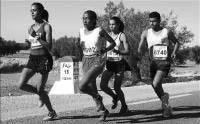Injuries are a runnerֳ worst nightmare and trying to avoid these injuries is key to successful training, however a high proportion of these problems are easily avoidable. Training technique accounts for the majority but incorrect or improper equipment can impact greatly on an athleteֳ ability to train effectively. This month we take look at some of the best ways to help youˡchieve an˩njury free marathon.
There is no glory in the practice but without the practice there is no glory.Ӡunknown
Most runners will admit they rarely feel injury-free and during the winter and cold weather training can prove to be a very unpleasant experience for some, as your joints are particularly susceptible to a drop in temperature. Knee injuries account for almost half of all running problems with osteo-arthritis commonly affecting the lower extremities. A simple but effective way to help ease the associated symptoms in mild conditions is to wear a protective layer helping to retain body heat, our own branded PhysioRoom.com Baselayer Compression Pants and PhysioRoom.com Baselayer Compression Long Sleeve Top offers an affordable way to help ensure your schedule remains on track.
“Run when you can, walk when you have to, crawl if you must; just never give up.” Dean Karnazes
Over-training is a problem especially at this stage, and one of the most frequent overuse injuries is Runnerֳ Knee which is also known as Ilio Tibial Band Friction Syndrome (ITBFS), this affects the outer part of the knee. Cold therapy can provide excellent pain relief post-run and during the early stages of this injury, the Aircast Knee Cryo/Cuff with Cooler provides up to eight hours continuous treatment. In mild cases of Runner’s Knee, a knee strap can help to effectively relieve the symptoms whilst running. The compressive forces above the knee cap reduce tension in the Ilio Tibial Band and ease the pain associated with this problem, PhysioRoom.com recommend the Mueller ITB Strap.
“The pain of training is nothing compared to the pain of not reaching your potential.” Josh Cox
With each and every step your feet absorb several times its own body weight resulting in heel pain and causing pain in the sole of the foot. The plantar fascia runs from the calcaneus (heel bone) to the under-surface of the toes and as you run the arch of the foot drops helping to preserve energy and dissipate the associated forces. This repeated action can cause inflammation of the plantar fascia usually at the point where it attaches to the heel bone, restricting the movement of the foot. Using the Aircast Plantar Fasciitis AirHeel will help to reduce swelling, discomfort and enhance circulation with every step.
Training for a marathon is hard, donִ make it any harder than it needs to be! Next month we look at tapering and preparation for˹our build-up to theˢig day!
Author : Ben Dinnery


